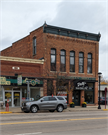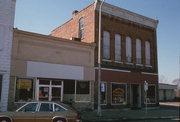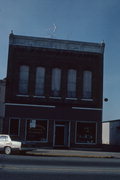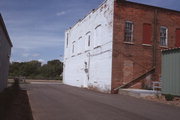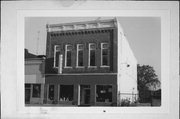Property Record
26 E MAIN ST
Architecture and History Inventory
| Historic Name: | Reedsburg Woolen Mill Office |
|---|---|
| Other Name: | GREENEWOOD'S RIVERVIEW CERAMICS |
| Contributing: | |
| Reference Number: | 16633 |
| Location (Address): | 26 E MAIN ST |
|---|---|
| County: | Sauk |
| City: | Reedsburg |
| Township/Village: | |
| Unincorporated Community: | |
| Town: | |
| Range: | |
| Direction: | |
| Section: | |
| Quarter Section: | |
| Quarter/Quarter Section: |
| Year Built: | 1891 |
|---|---|
| Additions: | 1934 |
| Survey Date: | 1983 |
| Historic Use: | small office building |
| Architectural Style: | Italianate |
| Structural System: | |
| Wall Material: | Brick |
| Architect: | |
| Other Buildings On Site: | |
| Demolished?: | No |
| Demolished Date: |
| National/State Register Listing Name: | Reedsburg Woolen Mill Office |
|---|---|
| National Register Listing Date: | 12/26/1984 |
| State Register Listing Date: | 1/1/1989 |
| National Register Multiple Property Name: | Multiple Resources of Reedsburg |
| Additional Information: | A 'site file' exists for this property. It contains additional information such as correspondence, newspaper clippings, or historical information. It is a public record and may be viewed in person at the Wisconsin Historical Society, State Historic Preservation Office. Architectural Description: Windows boarded over; bracketed metal cornice. This 2 1/2 story red brick office building and warehouse has a bracketed metal cornice with corbel and dentil brickwork below it. There are five bays with pointed arch brick window heads and stone sills. The windows are boarded over. Building dimensions are 32' x 70'. The first story has been remodeled with a plate glass and metal facade. The west side and rear of the building have arched brick window heads and many windows are boarded or bricked over and have new and smaller windows. Although the interior has been remodeled into a retail store, the essential integrity of the building remains. The former woolen mill office is located near the east bank of the Baraboo River at the western edge of the downtown business area. The land immediately adjacent to the river was the mill site and is now occupied by a 1984 printing plant. Historical Description: Although not early by Wisconsin standards--15 mills were recorded in the census of 1860 (C)--the Reedsburg Woolen Mill was the only such mill in the community and an important local industry. As early as 1873 the "Reedsburg Free Press" reported the possibility of beginning a woolen mill in Reedsburg. Reedsburg had a dam, a millwright, and local capital available. It also had a desire to be more than a trading post (A). This "culminated in a meeting of the then leading businessmen of Reedsburg at the law offices of Judge Lusk" and in 1879 the Reedsburg Woolen Mills were formed with $50,000 worth of stock (B). The mill was not built until 1881-82, probably with local capital. Although early records of the local mill are incomplete, there are reports of the mill shipping $7000 worth of cloth to Meyer, Strauss, Goodman and Company of Chicago in 1882. They also received orders from Chicago and St. Louis (D). Nevertheless, success was not long lasting and by January, 1883 action was taken to foreclose on the mill's $35,000 mortgage (E). However, the factory was kept running and the next month, stone was hauled to build a storeroom and office adjacent to the mill. On September 6, 1883 the "Reedsburg Free Press" reported that the mill "has an enviable reputation throughouth the country for producing stylish and acceptable clothes manufactured". Although "less than two years in operation", the mill was receiving orders from Chicago (F). The mills employed 40 people "when running" (H), but business remained unsteady and within two years they were for sale. No selling price was given but it was noted that "parties who own this property are inexperienced in the woolen mill business and will sell the property very cheap" (G). The newspaper reported in January that potential buyers were looking over the mill, and by March David B. Rudd (a banker in Reedsburg) had bought the mills (I), and in July, William French of Ann Arbor, MI "also has an interest" in the mill (J). On August 12, 1886 the "Reedsburg Free Press" announced that the mills would begin operating again that week, under the the administration of Rudd, J.W. Gale, and Ralph P. Perry (all of Reedsburg) and William French and his son (Harry). Most accounts of the mill say that Harry French (who was related to Mrs. William Doyle, an early Reedsburg settler) came here to look over the mill with the intention of buying it and shipping the parts east. He reconsidered once he saw the mill and persuaded his father to operate the mill locally. A partnership was formed with local men soon after this. The reorganization helped stabilize the business and by 1888 newspaper reports noted that the firm could not keep up with orders. Until this time the office and warehouse were part of the mill itself but in late 1890 the foundation was laid for a new office and warehouse building north-east of the mill. The two story brick building was 32' x 70' and had the office and cloth rooms on the first story and the sorting and warehouse rooms on the second story (L). The building was occupied by May 7, 1891 (SK8/20, 26 Main Street). Sometime around 1898-99 the Reedsburg Clothing Company was established to manufacture pantaloons. It was housed in part of the office building. D.O. Stine, an officer of the milling company and George Crane of Detroit, Michigan were the manager and superintendent, respectively. In 1904 they moved to Prairie du Chien. Otherwise, the 1891 building was used only by the mill as an office, store house, and retail store, although the mill complex included a four story processing and manufacturing building that underwent continual expansion (M). The business had grown to such an extent that the owners found it necessary to reorganize and incorporate with $100,000 capital in 1892. The original owners still held most of the stock after the company reorganized. By 1899 there were 32 broad looms in the mill, the mills were taking advance orders and working day and night shifts, and the firm did business in "fancy cassimeres" in Chicago as well as nationwide. In 1902 Appleton Woolen Mills bought the Reedsburg Woolen Mill for $30,000. Under the management of George Dunham, the plant expanded, hired 50 to 60 people and changed its name to Appleton Woolen Mills. The firm shifted production of apparel from Appleton to its Reedsburg mills and began textile production for the eastern fashion market. At first Appleton kept a tight control over the operation byt by the 1950s the mill had gained some autonomy of operation. There was a high turnover of unskilled workers and numerous layoffs, especially between 1914-1927 (N). In the 1930s Ralph Wirth was hired by the mill. He was both a designer and manager and was given credit for most of the textile designs produced at this time (N). All phases of wool production took place at the mill. This was not typical but gave the company greater control over the product. Sears and Montgomery Wards were two of the major customers buying the fancy or novelty wools produced here. Army blankets were also made during World War II. In 1954 Appleton decided to get out of the fancy wool production and concentrate on producing paper maker's felts at Appleton. At this time the Reedsburg mill employed between 150-180 people and had a payroll of $400,000-$450,000. Only Hankscraft, a manufacturer of baby products (est. 1949), employed more (200 people)(O). For many years the mill had been the largest employer in the city. A group of local businessmen organized to buy the company and sell stock. Wirth was named President and manager. Novelty fabrics became even more important to the company after it was run as an independent firm, with the belief that a small organization needed a distinctive product. In the late 1950s, 90 designs per year were produced and by 1963, 250 designs were made each year (N,B). Eventually foreign competition, popularity of synthetics, losses on government contracts (one was taken in 1963 just to keep the mill open), lack of operating capital, and fire caused financial difficulties. Although the mill was unionized, there is little information available (P). The death of Wirth, who produced most of the textile designs, in 1964 was an additional problem for the mill. In June, 1967 the company declared bankrupcy. The city lost 200 jobs and a $750,000 payroll. The Reedsburg Woolen Mills had been the last mills in the state to weave "fancy" textiles for the womens' fashion market. In 1975 only two other woolen mills were running (at Grafton and Appleton)(C). The mill burned down in April, 1968 and the dam was torn out in 1973. Today only the former office remains. This two story brick building has been used as a retail store. Historical Statement of Significance: The former Reedsburg Woolen Mills and Appleton Woolen Mills office building has local historical significance for its association with what was once a major employer and leading industry in Reedsburg. For over 80 years the woolen mill was active in Reedsburg providing employment in the mills and using local railroad shipping facilities, thereby generating more economic activity. It was the last mill in the state to weave novelty textiles in the competitive women's fashion market and one of the few where all phases of textile design were completed under one roof. The mill itself burned in 1968 and the office building which has retained much of its integrity is the only extant representation of the local woolen mill industry. |
|---|---|
| Bibliographic References: | A- "Reedsburg Free Press", March 7, 1873. B- "Reedsburg Free Press", August 22, 1895. C- "Wisconsin Then and Now", May 1975 (Vol. XX, No. 10), spectacular Reedsburg fire proved to be the end of large state industry, by Patricia Hilts. D- "Reedsburg Free Press", September 14, 1882. E- "Reedsburg Free Press", January 25, 1883. F- "Reedsburg Free Press", September 6, 1883. G- "Reedsburg Free Press", July 6, 1883. H- Sanborn-Perris Maps at SHSW, Madison. I- "Reedsburg Free Press", March 25, 1886. J- "Reedsburg Free Press", July 29, 1886. K- "Reedsburg Free Press", March 23, 1888. L- "Reedsburg Free Press", September 15, 1890. M- "Reedsburg Free Press", December 4, 1890 and July 16, 1891. N- Patricia Hilts. Thesis on woolen mills, in possession of Mrs. Ruth Wirth, Reedsburg. O- "Reedsburg Times-Press", May 5, 1954. P- There was a union in the 1950's according to Mrs. Ruth Wirth, Reedsburg, fall, 1983. Q- 1977 Reconnaissance Survey. Baraboo News Republic 5/10/2001. |
| Wisconsin Architecture and History Inventory, State Historic Preservation Office, Wisconsin Historical Society, Madison, Wisconsin |

